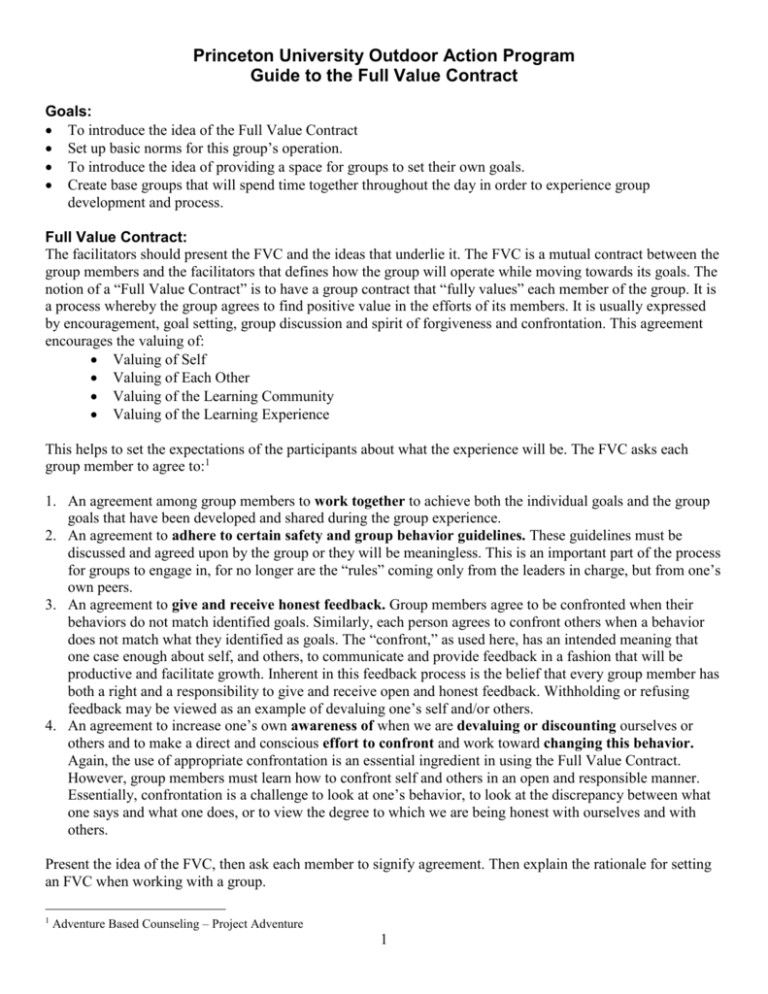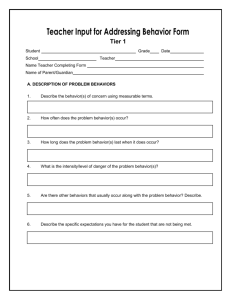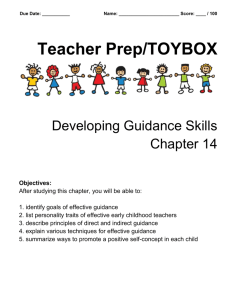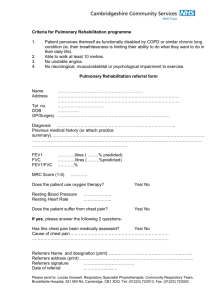Full Value Contract
advertisement

Princeton University Outdoor Action Program Guide to the Full Value Contract Goals: To introduce the idea of the Full Value Contract Set up basic norms for this group’s operation. To introduce the idea of providing a space for groups to set their own goals. Create base groups that will spend time together throughout the day in order to experience group development and process. Full Value Contract: The facilitators should present the FVC and the ideas that underlie it. The FVC is a mutual contract between the group members and the facilitators that defines how the group will operate while moving towards its goals. The notion of a “Full Value Contract” is to have a group contract that “fully values” each member of the group. It is a process whereby the group agrees to find positive value in the efforts of its members. It is usually expressed by encouragement, goal setting, group discussion and spirit of forgiveness and confrontation. This agreement encourages the valuing of: Valuing of Self Valuing of Each Other Valuing of the Learning Community Valuing of the Learning Experience This helps to set the expectations of the participants about what the experience will be. The FVC asks each group member to agree to:1 1. An agreement among group members to work together to achieve both the individual goals and the group goals that have been developed and shared during the group experience. 2. An agreement to adhere to certain safety and group behavior guidelines. These guidelines must be discussed and agreed upon by the group or they will be meaningless. This is an important part of the process for groups to engage in, for no longer are the “rules” coming only from the leaders in charge, but from one’s own peers. 3. An agreement to give and receive honest feedback. Group members agree to be confronted when their behaviors do not match identified goals. Similarly, each person agrees to confront others when a behavior does not match what they identified as goals. The “confront,” as used here, has an intended meaning that one case enough about self, and others, to communicate and provide feedback in a fashion that will be productive and facilitate growth. Inherent in this feedback process is the belief that every group member has both a right and a responsibility to give and receive open and honest feedback. Withholding or refusing feedback may be viewed as an example of devaluing one’s self and/or others. 4. An agreement to increase one’s own awareness of when we are devaluing or discounting ourselves or others and to make a direct and conscious effort to confront and work toward changing this behavior. Again, the use of appropriate confrontation is an essential ingredient in using the Full Value Contract. However, group members must learn how to confront self and others in an open and responsible manner. Essentially, confrontation is a challenge to look at one’s behavior, to look at the discrepancy between what one says and what one does, or to view the degree to which we are being honest with ourselves and with others. Present the idea of the FVC, then ask each member to signify agreement. Then explain the rationale for setting an FVC when working with a group. 1 Adventure Based Counseling – Project Adventure 1 It sets strong expectations for behavior. The FVC serves as a contract for group norms. It establishes a baseline to measure how the group is performing. To some extent the FVC doesn’t “come up” until someone is not living it and you ask “Well, are you living up to the FVC by that statement?” Play Hard2… Play Safe… Play Fair… Have Fun… Try your best. Play with spirit. Challenge yourself. Give 100%, with enthusiasm. Be involved in all activities and demonstrate commitment to the process. Play with intensity and seriousness. Avoid Careless risk. Look out for others. Practice Challenge by Choice. Show an awareness of your own and other’s bodies and abilities. Play within the boundaries of physical and emotional safety. Adhere to safety and group behavior guidelines Adhere to rules. Be honest. Play cooperatively and with respect. Be respectful of group members and value others, yourself, and the process. Allow equal opportunities for all to participate. Be aware of devaluing self and/or others and make a conscious effort toward changing this behavior. Show honest and respect for self and group members. There are a few other ground rules that should be explained as part of the FVC. These include: Challenge by Choice Right to pass. Respect the diversity of everyone in the group (race gender, sexual orientation, religion, personal beliefs). We all have a great deal to learn from each other. You don’t have to agree, but you need to listen honestly and think about how someone else sees the world. Be 100% Use gender inclusive language I Language & Eye Language Creating a Full Value Contract One activity for creating a Full Value Contract is to have the group create something physical that both symbolizes and embodies the group contract. Take newsprint or a sheet and have group trace their hand or some other part of themselves (even their whole body) on the contract. Then write their name and one or two things that they plan to contribute to the group (energy, humor, knowledge, etc.). Now around all the hands or bodies have the group brainstorm and write out their FVC. Have the group facilitators add any things that are needed into the FVC. Then display this as a reminder about what the group’s FVC is. 2 Adventure Based Counseling - Project Adventure 2 Activity 1. Have people write on one side of an index card 3-5 goals for the group to accomplish. 2. Have people write on the other side 3-5 personal goals for being part of this group. 3. Using sheets of newsprint get the group in a circle on the floor around the newsprint and have each person trace their hand on the newsprint and add their initials in the hand. 4. Add 1-3 things that you will contribute or bring to the group and write it in your hand tracing. 5. Go around the group and have people share and write in their goals for the group. Others should raise their hands if it was one of their goals to see commonality. It’s also a time for brainstorming and discussion to define and refine the group’s goals. Make sure to add the 4 Core Elements from above and Challenge by Choice (introduce this concept here). 6. Have the group stand up and look at the totality of their FVC. Now move to another position on the circle (to get a fresh perspective – can do this with a quick game like Go Bananas). 7. Now talk a bit about the actions, boundaries and guidelines that they will need to implement to reach their goals. Write these on the FVC and add an asterisk to be able to tell them apart from the initial goals. Some guidelines will also be goals. This helps pave the way for talking about managing behavior and natural consequences. 8. Now have the group stand up and look again at the totality of what thy have created. 9. Pair up individuals in the group to share 2-3 of their personal goals with their “goal buddy.” This is to create a support network within the group to help you focus and attain your personal goals for the program. Challenge by Choice: As a leader you may want to push someone to attempt a challenge, but know when to back off. This is a fundamental principal known as Challenge by Choice. At the final point addressing a challenge should be a personal decision by the participant, not something they are forced or pressured into. Accepting a challenge is a motivational choice. Yes, I will attempt it or No, I won’t attempt it. Support the person in either decision they make. If s/he chooses not to continue, let the person pass and be supportive in such a way so that they feel empowered by their willingness to try rather than devalued for not having achieved the task. Accept the individual’s choice, as long as it is not unsafe. Challenge by Choice is an important part of the Full Value Contract. It states that the individual should not be forced or coerced into an activity. In some situations (e.g. bad weather) there is nothing we can do. But in most situations activities are voluntary people must feel the have the right to say no and not feel a loss of self-worth. This is part of creating a Safe Environment. The chance to try a potentially difficult and/or frightening challenge in an atmosphere of support and caring. The opportunity to “back off” when performance pressures of self-doubt become too strong, knowing that an opportunity for a future attempt will be available. The chance to try difficult tasks, recognizing that the attempt is more significant than performance results. Respect for individual ideas and choices. Thaw-Shift-Refreeze - the basic model of how we change our behavior. Often it is a challenge or disequilibrium that initiates the Thaw and a supportive environment is usually required to help Refreeze the new behavior. Challenge - challenge is often a fundamental part of the Thaw-Shift-Refreeze Cycle. A challenge occurs when there is a goal and an obstacle to overcome to reach the goal. The goal can be internal or external and the obstacle can be internal or external. If the participant attributes the locus (internal vs. external) of either the goal or obstacle incorrectly, it may lead to frustration. The person may need help seeing the situation more clearly. Remember that each person will have different things, which challenge him or her and will experience a challenge in different ways. 3 Setting Group Goals: In any group that comes together there must be goals. In some cases the facilitators will have a set of goals for the group. In other cases the group itself must determine it’s goals. As facilitators we have established a series of goals for this workshop and the ones that follow. At the end of each section of the workshop we will talk about the goals that we identified and you can give us feedback on how well the activities worked to reach those goals. Also, we want the group itself to set goals for the rest of the day and for each individual to set goals for the day. (5 minutes) To set effective goals, set SMART goals: S - Specific - one goal at a time, stating exactly what you are responsible for. M - Measurable - the goal must be stated so that it is measurable in time and quantity A - Achievable - the goals must be accomplishable or reasonable R - Relevant - a goal is relevant if it addresses an activity, which makes a positive difference in overall performance. T - Testable - a goal should set in a way that allows you to monitor your progress Natural Consequences: Whenever dealing with behaviors and established goals, you also need to identify consequences for not following certain behaviors, these are consequences. For example, if you go outside in a rainstorm without an umbrella, you’ll get wet. That is a natural consequence of not having an umbrella. Consequences can be both positive and negative. Too often it seems that we manage negative behavior based on responding to it with negative consequences. Also remember that you can create and motivate positive behavior by creating positive consequences. Depending on your group or program, you may have pre-established consequences for behaviors (such as expulsion from a program for violence). If so, these must be communicated to participants at the outset. In other cases, consequences may be developed on the fly and in some cases with the participants. (This is usually done only on longer programs). Since you cannot anticipate all possible behaviors, leaders will need bring up other consequences if and when the situation arises. It’s best if there is some congruence between the level on consequence and the level of behavioral violation. Have the consequence be something related to the breaking of the contract. Examples: Class Project - WWS Policy conference. The contract is to go 3 hours each night and everyone be on time. Everyone has to be there before you start. So if people are late, the 3 hours goes later. Everyone has an interest in keeping to the contract PBC - no rock throwing. If someone throws a rock the entire group must pick up a rock and hold it silently for 5 minutes. Then put the rock down saying, “we don’t throw rocks.” If anyone breaks the silence before 5 minutes, the clock starts again. The 4 R’s of Natural Consequences Consequences should be 1. Realistic 2. Relevant 3. Right Away 4. Respectful Individual Group Consequences In any group situation, the facilitators need to decide where on the continuum the response is for dealing with behavior with individual consequences or group consequences. There are no right or wrong approaches only the differing needs of different groups. One possible focal point is identifying all behaviors that are unsafe, as 4 things to deal with on an individual consequence level and things outside of safety issues on the FVC group consequence level. This leaves open for discussion what is “unsafe.” Applied by Facilitators Developed by Group Consensus There is also a continuum of when consequences should be developed and/or implemented by the facilitators and when the group should help decide on consequences. Consequences for: Individual Consequences Created by: Leaders Group Group Leaders Group Consequences Implemented by: Leaders Group Leaders Group Leaders Group Leaders Group Princeton-Blairstown Center Model 1. Create a Full Value Contract. 2. Call each other when some behavior violates the contract. Bring the group together as soon as possible after the infraction. 3. Have an initial meeting of the group to identify the behavior that violated the contract and have the group come up with an appropriate consequence that follows the 4 R’s (either through consensus or guided discussion). 4. At the next infraction, implement the new consequence. 5. If the consequence is ineffective, review it as a group and decide if you need a different consequence. Descriptions of Natural Consequences Choices Immediate Constructive Realistic Understood Self-imposed Uniform/Universal Obvious Logical Relevant Impersonal Fair Age & other appropriate Positive Consequences Negative Consequences Constructive Communal Creative Memorable Deterrent OK to fail Creating Natural Consequences 1. Define Natural Consequences 2. Have the group brainstorm on newsprint about what Natural Consequences embody Philosophy of Experiential Education: Thaw-Shift-Refreeze & Challenge Goals: To introduce the ideas of why outdoor education is so powerful To understand the Thaw-Shift-Refreeze model and its place in Situational Leadership. To understand how people experience challenge 5 Process of Growth: The process of personal growth is described by a model of experiential learning known as the Thaw-ShiftRefreeze Cycle. This model assumes that we each have a developed set of behaviors and attitudes. When we are placed in a new situation, our old behaviors may not be appropriate. So there is a thawing period during which new behaviors/skills can be learned. If these new behaviors work well, and are properly reinforced, they refreeze and the person incorporates a new set of behaviors. It is essential to remember the following points: New behaviors are learned primarily from the leaders. It may be a challenge/stress situation (such as hiking in a downpour - see Challenges below) that initiates the Thaw-Shift-Refreeze Cycle. There may be anxiety during the Shift process while the person casts of old “safe” behavior and struggles to learn new behavior. The wilderness provides an excellent “classroom” for this type of development. An outdoor environment, in a small group setting provides an immediate and simplified environment. You are dealing with basic issues like staying warm and dry, feeding yourself, and traveling from A to B. As a result the skills you need are basic ones which give you immediate feedback. If you didn’t set the tarp up right, you get wet. Thus participants are in an environment where new behaviors are learned quickly. The other essential part of the situation is the group. A small group setting (8-12) provides for diverse interaction and sharing yet also is small enough so that close relationships can be formed. The interconnections between people in the group are essential for providing support and encouragement as people face challenges and learn from them. Once again the leaders must work to facilitate effective group interaction. Dealing With Problems Problems can often be divided into personality related or physically related (injury, environment). Some possible situations are given below. 1. Correcting Group Action/Decision 6 Is there a safety consideration? Is the decision necessary to correct? If the answer to either of these questions is yes, the decision must be changed, in doing so: Act quickly to avoid safety problems. Be subtle in transmitting information. It may be just to one participant and not involve the rest of the group. Maintain the worth of all group members and their input even though you must alter the decision. 2. When dealing with someone having difficulty with a challenge: Move the situation to focus on something outside the person. Break it into discrete, do-able parts. Refocus the persons on a level of challenge appropriate to them. 3. If a person is creating a problem it is essential to accept the person and let them know they are still important, but you do not have to accept the behavior. Make it clear that the problematic behavior cannot continue. 4. Feeling of lack of control leading to fear can be one of the greatest motivations for negative behavior. If someone is behaving negatively, they may be compensating and trying to create a sense of selfempowerment and control. When you see negative behavior ask yourself what needs for that person are not being met that may be resulting in negative, compensating behavior. 5. In dealing with problems try to turn the problem into a solution - flip it 180 degrees. “Your disability is your opportunity.” - Kurt Hahn Example: Sarah is constantly hiking ahead of the group. She is in good shape and out distances everyone else. She thinks the group is too slow and everyone should catch up with her. Let her know that the challenge for some other is just hiking. She doesn’t have that challenge. Instead her challenge is to slow her pace down and stay back with the others using her strength to help the others. You have flipped a problem into a solution. Dealing with Someone who is Out of Control Sometimes you may get into a situation where the other person is really having difficulty and their behavior is getting out of control, what is often known as an “in your face” situation. Here are some techniques you can use to settle the situation out. Recognize from early on when you are in an “in your face” situation or when things are escalating in that direction. Know what pushes your buttons. Don’t just enter a conversation expecting your own outcomes. Recognize what the other person’s outcomes may be. Not being sensitive to the other person’s needs can often escalate things into “in your face.” Know when to put off a conversation until another time. Sometimes emotions are running too high to have a productive conversation. Know when the discussion needs to be private. Other times you may want corroboration from your coleader that can’t come with a private discussion. Don’t interrupt people. If someone is out of control, interruption probably won’t get them back in control. Best to let them have their say completely and then comment if it seems appropriate. Give up being invested in making your own point. If things are out of control, you don’t want to feed the fire by trying to get your own point across. Let it be, at least until later. Spend your energies trying to reduce the anxiety. After things have calmed down, have another discussion if necessary to get back to your points. 7 Go into active listening mode. Rephrase the person’s comments so they know you have heard them. Read between the lines and ask yourself what is going on with this person that is motivating them to act this way. Remember compensating behaviors. If appropriate, you can tell them you disagree with their points and list your reasons. As you rephrase the person’s statements, be prepared to apologize if your find that they have interpreted you in an objectionable way. “It sounds as if you are frustrated with my telling you that you can’t hike by yourself. I apologize if that offends you, however, it is the standard OA policy that the group should stay together for safety reasons.” Don’t raise your voice or change your physical presence. Stay cool and collected. Changes indicating your anxiety will only raise the level of tension. Monitor your tension level. Take a psychological “deep breath” and chill. This process may need to go on while the other person is talking. 8








